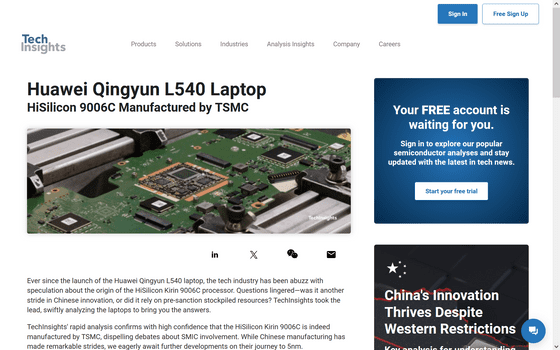A teardown reveals that the 5nm chip installed in Huawei's notebook PC 'Qingyun L540' announced in 2024 was made by Taiwanese TSMC in 2020.

In the United States, restrictions have been placed on the import and export of Chinese products since around 2019, and Huawei products, which are widely sold not only in China but all over the world, have been in a particularly difficult situation. It was reported that Huawei, which has found it difficult to purchase parts from the United States, is making it possible to manufacture self-sufficient products with the help of the Chinese government, but an investigation that disassembled Huawei products revealed that Chinese technology The current situation has become clear.
Huawei Qingyun L540 Laptop: HiSilicon 9006C Manufactured by TSMC | TechInsights

Huawei Qingyun L540 Laptop Teardown Reveals 5nm Chip by TSMC, Not China's SMIC - Bloomberg
Huawei's 5nm Kirin 9006C laptop chip was reportedly produced by TSMC in 2020, dispelling production rumors at Chinese fab SMIC | Tom's Hardware
https://www.tomshardware.com/tech-industry/semiconductors/huaweis-5nm-kirin-9006c-laptop-chip-was-reportedly-produced-by-tsmc-in-2020-dispelling-smic-production-rumors
Huawei has long been known to have built its own network to manufacture devices to circumvent American regulations. In particular, with regard to semiconductors used in smartphone manufacturing, we secure uniquely designed semiconductors through China's semiconductor foundry Zhongxin International Integrated Circuit Manufacturing Co., Ltd. (SMIC), which will be used in the ' Mate 60 Pro ' announced in 2023. It was also revealed that Huawei's first proprietary 7nm process was adopted.
On the other hand, some believe that it has been extremely difficult to secure semiconductors manufactured using the even higher performance 5nm process. Semiconductor manufacturing requires extreme ultraviolet lithography (EUV) equipment, but ASML, the manufacturer that handles this equipment almost exclusively, has been subject to export restrictions to China, so China has replaced it with deep ultraviolet lithography (DUV) equipment. I had no choice but to use . Although China has succeeded in manufacturing the 7nm process using DUV equipment, it has fallen far behind other countries in manufacturing the 5nm process.
Huawei is building a self-sufficient chip network by overcoming US economic sanctions - GIGAZINE

However, in 2024, it was discovered that the notebook PC ' Qingyun L540 ' announced by Huawei uses semiconductors manufactured using the 5nm process, and SMIC has finally reached the point where it can manufacture products using the 5nm process. Expectations and suspicions were raised that this might be the case. Therefore, TechInsights, which specializes in technical analysis, actually disassembled Qingyun L540 and revealed the identity of the manufacturer.
According to TechInsights, the chip used in the SoC 'Kirin 9006C' used in Qingyun L540 was not made by SMIC, but was made by Taiwanese semiconductor foundry TSMC. Furthermore, it seems that the specifications of Kirin 9006C are similar to Kirin 9000 manufactured in 2020.

The Kirin 9000 was manufactured just before export restrictions were imposed on TSMC, and is the chip that was also used in the smartphone ``Mate 40'' announced in October 2020. It is known that the Kirin 9000 installed in the Qingyun L540 was packaged during the week of August 24, 2020, and it is believed that it was stockpiled for some reason and is now being used.
This discovery dispels speculation that SMIC has enabled mass production using the 5nm process, and as the market's expectations were disappointed, SMIC's stock price fell 2% after the news was reported.
Related Posts:
in Hardware, Posted by log1p_kr






